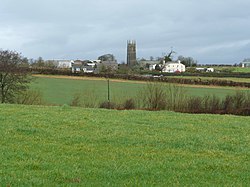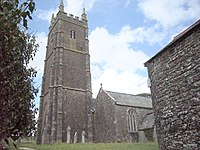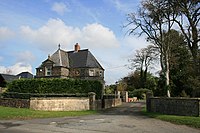Monkleigh
| Monkleigh | |
| Devon | |
|---|---|
 Monkleigh | |
| Location | |
| Grid reference: | SS455204 |
| Location: | 50°57’45"N, 4°12’1"W |
| Data | |
| Post town: | Monkleigh |
| Postcode: | EX39 |
| Dialling code: | 01805 |
| Local Government | |
| Council: | Torridge |
| Parliamentary constituency: |
Torridge and West Devon |
Monkleigh is a village in northern Devon, and which to be found two and a half miles north-west of Great Torrington and three and a half miles south-east of Bideford. Located west of the River Torridge valley, the village sits on high ground with scenic views of the parish. It is part of the Shebbear Hundred.
The parish includes the hamlets of Saltern Cottages (also known as Annery Cottages) and Annery kilns,[1] both of which are historic listed sites.
Name
The name of the village, Monkleigh, originates from the Old English leag, meaing 'meadow'; it appears named "Lega" in the Domesday Book of 1086. The name "Munckenelegh" appears in 1244, meaning 'Monks' leigh', as the property was at that time owned by the Montacute Priory.[2]
Parish church

The parish church, St George's, is of the early 15th century. Sir William Hankford, Chief Justice of the King's Bench, left monies for the church to complete construction of the south aisle in his will. He stipulated that the south aisle should be reserved for his and his heirs burial. Hankford died in 1423; at that time the fabric was being rebuilt. Hankford was buried in a canopied alter-tomb.
The Annery aisle has bench-ends decorated with the arms of the Annery manor families and emblems of the Passion. Tiles from the late mediæval period are found in the aisle and the nave. A kneeling effigy of James Coffin, Esquire (1566) in armour sat on a high tomb and was since destroyed. Pevsner stated that a small monumental brass of a kneeling knight, affixed to a stone tablet, and with heraldic escutcheons of the arms of Coffin, is dated from the 16th century.[3][4] Sir James St. Leger (1509) is represented in brass.
From 1862 to 1863 the church was restored. According to Pevsner, it contains one of the most remarkable mediæval wooden screens in Devon;[3] It is a detailed parclose screen that may date to 1537 when Dame Anne St. Leger founded a chantry in the chapel.
History
In 1887, John Bartholomew, Gazetteer of the British Isles, described Monkleigh as a village and a parish. It had a population of 540 people, covered 2,177 acres, and had property that belonged to the Montacute monastery.[5]
Monastery
William, Count of Mortain, the founder of the Montacute Priory, gave the Monkleigh manor to the priory during the reign of King Henry I (1100–1135).[6][7] It was owned by the Montacute Priory[8] in Somerset until the Dissolution of the Monasteries (between 1536 and 1541).[9]
Monkleigh manor
When the monasteries were dissolved, the manor was granted by the crown gratis on 26 August 1540 to James and Anne Coffyn (also Coffin) of Alwington for the term of Anne's life.[9] In June 1544, the Crown granted the manor to Sir John Fulford of Dunsford and Humphrey Colles of Barton, Somerset.
In 1810 the manor of Monkleigh was owned by Rev. John Pine-Coffin of Portledge, Alwington, from the same family as James Coffyn.[10] About 1823 Richard Pine-Coffin sold Monkleigh manor land to John Rolle, 1st Baron Rolle for the development of the Rolle Canal.[11]

Annery, historic estate
The former historic estate of Annery was a neo-Classical mansion house that stood in a "fine timbered park" dating back to the 13th century or before. An early owner was Osbert of Annery.[8] By 1260 the house was owned by the Stapeldons; Walter de Stapeldon was born in the Annery that year and later became the Bishop of Exeter from 1307 to 1326 and King Edward II's Lord High Treasurer. After the Stapeldons, it was owned by Sir William Hankford.[8] The Annery fell into decay and in 1800 a new building was built on the grounds of the mediæval building.[12][13]
The house was demolished in 1957.[12]
The ruins of the lime Annery kiln, built about 1823–1824 for Lord Rolle, are located along the River Torridge. Limestone was brought from Caldy Island and Gower Peninsula.[14]
Outside links
| ("Wikimedia Commons" has material about Monkleigh) |
References
- ↑ William White (of Sheffield.) (1879). History, Gazetteer and Directory of the County of Devon: Including the City of Exeter, and Comprising a General Survey of the County .... White. p. 550. https://books.google.com/books?id=n9sWAQAAIAAJ&pg=PA550. Retrieved 24 June 2013.
- ↑ Gover, J. E. B. & Mawer, A. & Stenton, F.M.: 'Place-Names of Devon , Part' (English Place-Names Society, 1931/2), page 503
- ↑ 3.0 3.1 Nikolaus Pevsner: The Buildings of England: Devon, 1952; 1989 Penguin Books ISBN 978-0-300-09596-8
- ↑ The Visitations of the County of Devon: Comprising the Heralds' Visitations of 1531, 1564 & 1620. Exeter. 1895. p. 208.
- ↑ "Descriptive Gazetteer Entry for Monkleigh". Vision of Britain. http://www.visionofbritain.org.uk/descriptions/entry_page.jsp?text_id=1927150&word=NULL. Retrieved 23 June 2013.
- ↑ Parishes: Maker – Musbury – Magna Britannia: volume 6 Devonshire | year=1822 | accessdate=24 June 2013 | author=Daniel and Samuel Lysons | pages=326–360}}
- ↑ Richard Nicholls Worth (1895). A history of Devonshire: With sketches of its leading worthies. E. Stock. p. 158. https://books.google.com/books?id=EoA2AAAAMAAJ&pg=PA158. Retrieved 24 June 2013.
- ↑ 8.0 8.1 8.2 Risdon, Tristram: 'A Survey of Devon' (1632), 1810 edition, p 276–277
- ↑ 9.0 9.1 Gt. Brit. Court of Augmentations; Joyce A. Youings (Ed) (1955). Devon Monastic Lands; Calendar of Particulars for Grants 1536–1558. pp. 39–41.
- ↑ Risdon, Tristram. Survey of Devon, 1810 Additions. p. 422.
- ↑ Scrutton, Susan (2006). Lord Rolle's Canal, Great Torrington. p. 30.
- ↑ 12.0 12.1 National Heritage List 1105127: Annery House
- ↑ "Annery House". Archaeology Data Service. 2 March 2006. http://archaeologydataservice.ac.uk/catalogue/adsdata/arch-721-1/dissemination/pdf/southwes1-27611_1.pdf. Retrieved 24 June 2013.
- ↑ Annery Kiln
- The Visitations of the County of Devon: Comprising the Heralds' Visitations of 1531, 1564 & 1620. Exeter. 1895.
